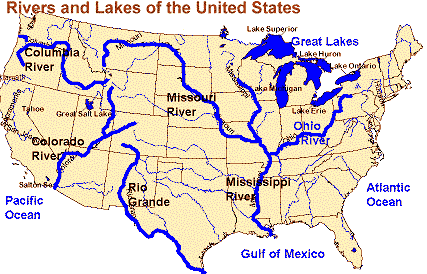STANDARD US1.2c
c) locate and identify the water features important to the early history of the United States: Great Lakes, Mississippi River, Missouri River, Ohio River, Columbia River, Colorado River, Rio Grande, Atlantic Ocean, Pacific Ocean, and Gulf of Mexico.
Bodies of water support interaction among regions, form borders, and create links to other areas.
What are the major bodies of water in the United States?

What are some ways bodies of water in the United States have supported interaction and created links to other regions?
• Trade, transportation, and settlement
• The location of the United States, with its Atlantic and Pacific coasts, has provided access to other areas of the world.
Major bodies of water
• Oceans: Atlantic, Pacific
• Rivers: Mississippi, Missouri, Ohio, Columbia, Colorado, Rio Grande
• Lakes: Great Lakes
• Gulf: Gulf of Mexico
• The Atlantic Ocean served as the highway for explorers, early settlers, and later immigrants.
• The Ohio River was the gateway to the west.
• Inland port cities grew in the Midwest along the Great Lakes.
• The Mississippi and Missouri Rivers were the transportation arteries for farm and industrial products. They were links to ports and other parts of the world.
• The Columbia River was explored by Lewis and Clark.
• The Colorado River was explored by the Spanish.
• The Rio Grande forms the border with Mexico.
• The Pacific Ocean was an early exploration route.
• The Gulf of Mexico provided the French and Spanish with exploration routes to Mexico and other parts of America.